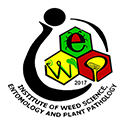Diagnostic Services
The following laboratory analysis are applied for diagnosis based on the client’s need:
- Visual assessment
- Microscopy analysis
- Pathogen isolation and processing
- Serological testing (Enzyme-linked Immunosorbent Assay)
- Molecular testing (Polymerase Chain Reaction, Nucleotide Sequencing, etc.)
Guidelines on Diagnostic Services
Clients may go directly to IWEP Pest Clinic or send their specimen via courier.
Please follow the pointers on sample collection and submission of specimens.
Pointers on submission of diseased plant specimens
- Collect samples of plants or plant parts bearing the disease symptoms or presence of signs of the pathogen.
- For leaf samples, wrap the detached sample in a clean paper towel or any paper, and then place in a plastic bag, and keep them in a cool condition during transport. Avoid the samples from getting wet to avoid spoilage of samples. Foo shoot, root or fruit samples samples, place them in a plastic bag and follow the same condition during transport.
- Submit the collected fresh samples immediately to the Pest Clinic not later than 2 days after collection.
- Label the samples properly indicating information on the crop affected, date and place of collection.
Pointers on submission of soil samples for nematode detection
- Collect soil subsamples from the outside and inside turf patches (see figure below) about 20cm deep composited to approximately 1kg per site. For the inside patches (B and C), include the root tissues as samples.
- Submit the collected samples immediately to the Pest Clinic days within 48 hours after collection.
- In case of a rainy day/season, perform collection 3-5 days after a heavy rain or until the soil dries up to field capacity.
Pointers on submission of insect specimens
The collected Insect specimens may be preserved following the wet preservation or dry preservation methods.
- Wet preservation: Collect insect samples and place them in a leakproof plastic or glass bottle (preferably 1 insect specimen/container) containing a technical grade 70-95% ethyl alcohol solution.
- Dry Preservation: Collect insect samples, and pin them properly and store inside a hard-cardboard box (preferably 1 insect specimen per box)
- Properly label the samples such as date and place of collection.
Pointers on submission of weed specimens
- Collect weed specimens including leaves, stems, flowers, pods or fruits and/or vegetative propagules.
- Place the fresh specimens in plastic bags secured with rubber bands or strings to prevent wilting.
- Submit the collected samples immediately to the Pest Clinic not later than 2 days after collection. Clients are encouraged to hand carry weed specimens to the Pest Clinic.
Service Fees and Charges
The Pest Clinic offers its services free* of charge to farmers. Service fee applies for private farms and other institutions. Charges will be communicated accordingly, and paid thru UPLB Foundation Inc.
* appropriate service fees may be charged should there be a need for further analysis
Other Pest Clinic services
Phytosanitary Certification
Disease Indexing
Training on Pest Identification and Management
Consultation
Field Visit
Sale of Aedes aegypti mosquito eggs
To avail other Pest Clinic services and for more information, please contact us via email or phone.

